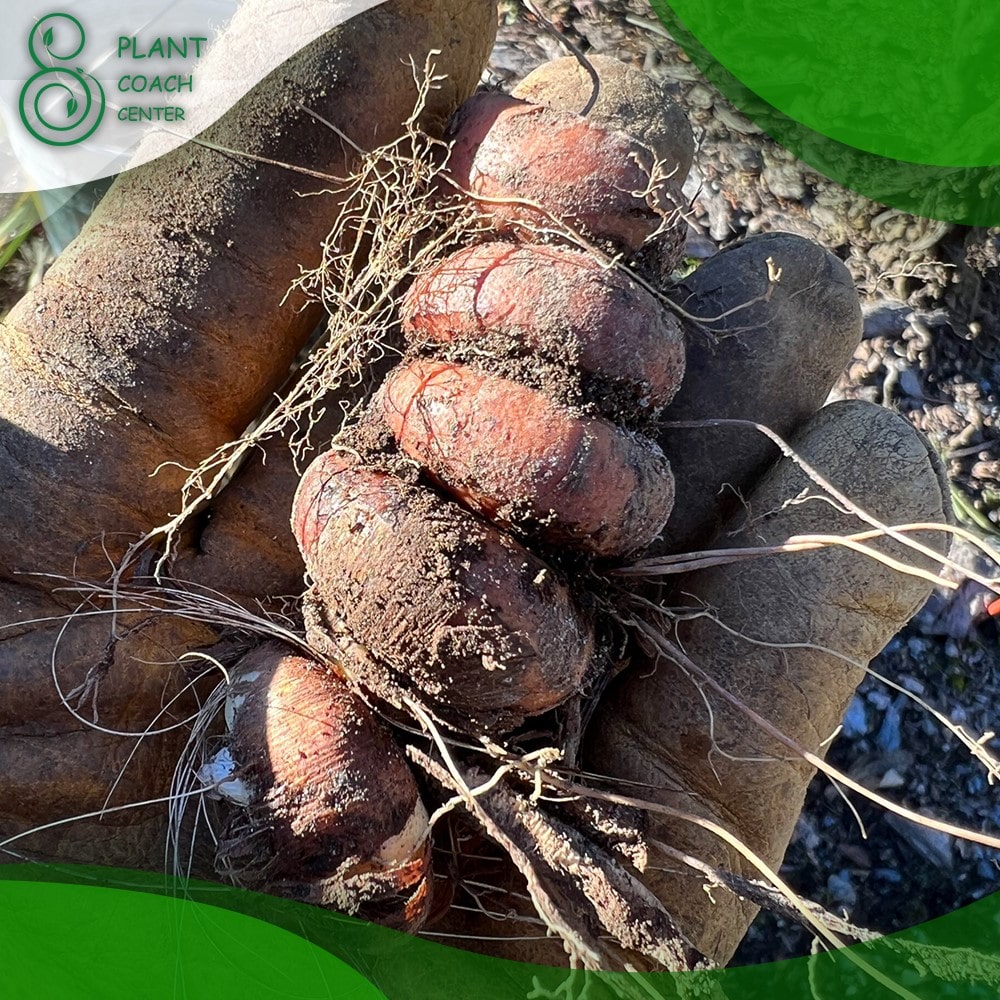When to Divide Crocosmia?
Welcome to the world of Crocosmia, where bursts of vibrant hues and elegant arching stems grace gardens with a touch of exotic allure. These captivating plants, known for their fiery blossoms and sword-like foliage, have an uncanny ability to infuse any landscape with a sense of drama and sophistication.
Yet, as they weave their intricate tapestry of colors, Crocosmia plants sometimes outgrow their initial homes, leading us to the art of division—an act beyond gardening science, becoming a testament to the magic of nurturing nature. In exploring “When to Divide Crocosmia,” we embark on a journey that uncovers the secrets behind reinvigorating these botanical wonders.
By understanding the signs, seasons, and strategies of the Crocosmia division, you’re poised to master the art of horticultural rejuvenation and capturing nature’s vivacity in every corner of your garden.
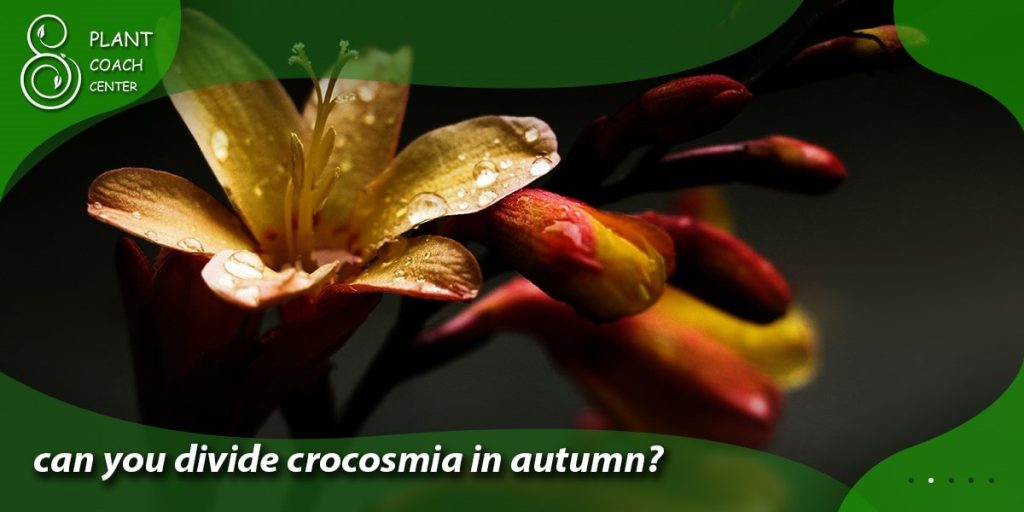
Unlocking the Splendor: Understanding Crocosmia Division
In gardening, few acts hold as much promise and potential as the art of division. It’s a practice that transcends mere horticulture, allowing us to glimpse into the inner workings of plant vitality and unleash their hidden splendor. Crocosmia, with its strikingly vibrant blooms and architectural elegance, is no exception to this phenomenon. Understanding the intricacies of the Crocosmia division grants us a backstage pass to the plant’s journey from a single rhizome to a dazzling display of colors.
At its core, Crocosmia division is a rejuvenation process akin to giving your plants fresh air. Over time, these dynamic perennials can become overcrowded, leading to decreased flowering, stunted growth, and even disease vulnerability. By gently teasing apart the tangled rhizomes—the underground storage structures responsible for nutrient uptake and energy storage—gardeners can revitalize the plant’s energy, encouraging robust growth and ensuring a renewed burst of blooms.
Timing, as they say, is everything, and in the case of Crocosmia division, it couldn’t be more accurate. To truly unlock the splendor of these plants, one must know when to intervene. The signs are often subtle yet telling: a gradual decline in the number and size of flowers or a center that appears tired and less vigorous compared to the plant’s periphery. These indicators signal that the plant’s resources are being stretched thin. By dividing Crocosmia during its dormant periods, typically in early spring or after the blooming season in late summer, you tap into the plant’s natural rhythms, allowing it to recover and thrive.
However, this process isn’t merely about rescuing a plant in need; it’s about fostering a deeper connection with the green wonders surrounding us. By understanding the intricate balance of the Crocosmia division, we enhance their beauty and become active participants in their life cycles. As we delve deeper into the realms of timing, technique, and the transformative effects of division, we’ll unearth the secrets that unveil the full splendor of Crocosmia—a reminder that in the gardening world, unlocking nature’s mysteries is a worthwhile endeavor.
Signs of Readiness: Identifying When Your Crocosmia is Due for Division
In the intricate dance of gardening, plants often communicate their needs through subtle visual cues, inviting us to step closer and lend a helping hand. Crocosmia, with its flamboyant display of blooms and graceful foliage, is no exception. As these botanical performers grow and evolve, they drop hints that they’re ready for their own encore—dividing to reveal even more captivating displays.
One of the critical signs that your Crocosmia is ripe for division is the phenomenon of overcrowding. Much like a bustling city where space becomes a luxury, a crowded plant clump can stifle growth, limit access to nutrients, and reduce the splendor of its blooms. Observing a decline in the number, size, or vibrancy of flowers can indicate that your Crocosmia is struggling to thrive amidst the tight quarters.
Another telltale sign lies in the health of the foliage. If the leaves at the center of the clump appear weaker, smaller, or less vibrant compared to the outer leaves, it’s a sign that the plant’s resources are unevenly distributed. This is a subtle SOS from the plant, signaling it’s time to intervene and restore its vigor.
As Crocosmia reaches the end of its blooming cycle, the spent flower stalks can also provide valuable clues. If these stalks become increasingly dense and congested, the plant has likely outgrown its current setting and is yearning for more space to breathe and flourish.
By tuning into these silent signals, gardeners can forge a deeper connection with their Crocosmia, enhancing the plant’s health and the overall aesthetic of the garden. By addressing the signs of readiness for division, you’re setting the stage for a rewarding performance—ushering in a new chapter of growth, color, and vitality that will leave you and your Crocosmia applauding in appreciation.
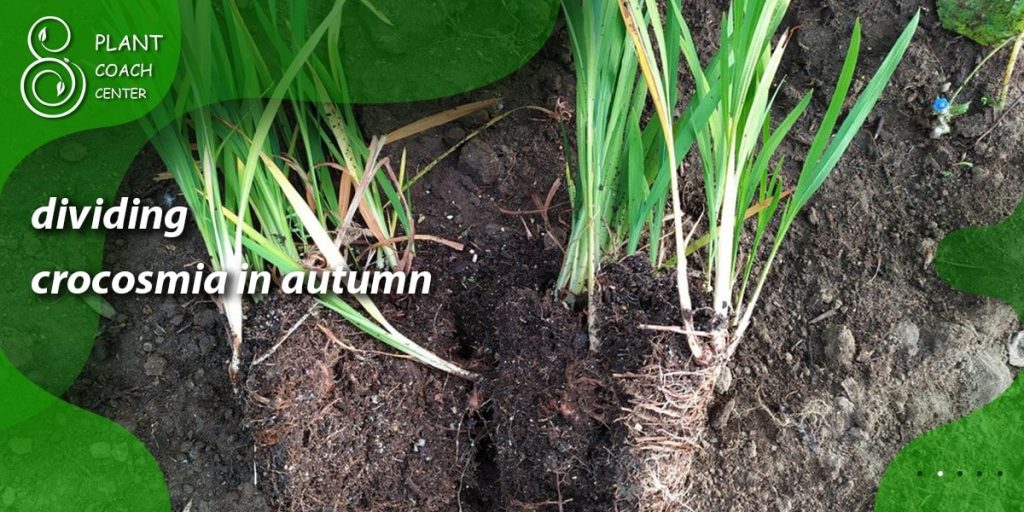
Timing for Triumph: Best Seasons to Divide Your Crocosmia
As the seasons ebb and flow, so does your garden’s rhythm. Understanding the optimal moments to perform various gardening tasks can make all the difference in ensuring the triumph of your flora. Regarding the vibrant world of Crocosmia, timing is a crucial factor in achieving the most successful divisions and bountiful displays of color.
Spring Splendor
Spring is a season of renewal, and it’s no surprise that it’s one of the prime moments to embark on the Crocosmia division. As the plant emerges from its winter slumber, the early days of spring present a unique opportunity to divide your Crocosmia. Just as nature awakens, so too will your plants, ready to embrace the rejuvenating effects of division. Dividing Crocosmia in early spring—before active growth begins—allows ample time for the newly separated rhizomes to establish their roots and get a head start on the growing season.
Fall Facelift
As the sun starts to wane and the garden prepares for its seasonal rest, the fall months offer another window for the Crocosmia division. Dividing your plants after they’ve completed their summer blooming cycle is a way to prepare them for the coming winter and set the stage for robust growth in the following spring. The cooler temperatures and milder fall sunlight provide a gentle environment for newly divided plants to adapt and establish themselves without the stress of scorching heat.
Choosing between spring and fall divisions often depends on your climate and local conditions. Cooler climates may find fall divisions advantageous, while warmer regions prefer spring divisions to allow for successful establishment before summer heat. Whichever season you choose, be sure to work with your garden’s rhythm, capitalizing on the unique attributes each time of year offers.
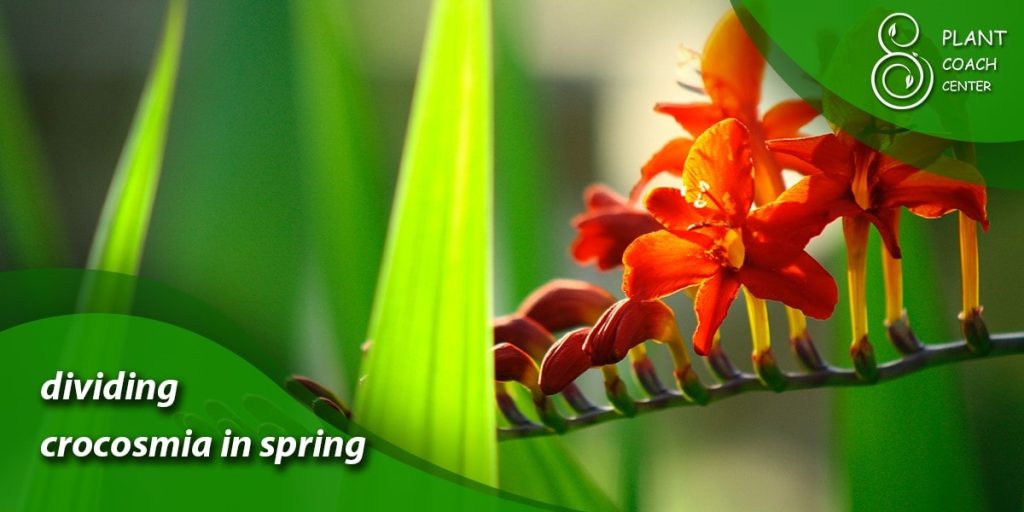
Getting Your Hands Dirty: Step-by-Step Guide to Dividing Crocosmia
Embarking on the journey of dividing Crocosmia might seem daunting, but fear not—this step-by-step guide will easily take you through the process, ensuring that your plants receive the care they deserve and the opportunity to thrive again.
Step 1: Choose the Right Time
As discussed earlier, select the appropriate season for division: early spring or late summer/early fall. This is essential for the successful establishment of your newly divided plants.
Step 2: Gather Your Tools
Assemble the necessary tools: a sharp garden knife, gardening gloves, a spade or garden fork, and a watering can. Keeping your tools clean and sharp ensures a smooth division process.
Step 3: Prepare the Plant
Water the Crocosmia a day before division to hydrate the rhizomes and make them easier to work with. Gently lift the plant from the soil using the spade or fork, not damaging the rhizomes.
Step 4: Inspect and Divide
Examine the rhizomes for natural divisions or areas where they can be separated. Using the garden knife, carefully cut through the rhizomes to create individual sections, ensuring each division has healthy roots and shoots.
Step 5: Trim and Clean
Trim any damaged or dead roots and foliage from the divisions. This promotes healthy growth and prevents the spread of diseases.
Step 6: Replant
Choose new planting locations with well-draining soil and partial to total sun exposure. Dig deep and wide holes to accommodate the divided rhizomes, ensuring they are planted at the same depth.
Step 7: Water and Mulch
After planting, thoroughly water the newly divided Crocosmia to settle the soil around the roots. Apply a layer of mulch around the plants to retain moisture and suppress weed growth.
Step 8: Aftercare
Monitor the newly divided plants closely in the weeks following division. Keep the soil moist but not waterlogged to aid in root establishment. Once the divisions show new growth, you can resume regular watering and fertilization.
Tools of the Trade: Essential Equipment for Successful Crocosmia Division
Embarking on the journey of dividing Crocosmia plants requires more than just a green thumb; it demands the correct set of tools to ensure a seamless and successful process. These essential gardening instruments will make the task easier and contribute to the health and vitality of your beloved plants.
Sharp Garden Knife
A sharp and sturdy garden knife is your primary tool for cleanly and effectively separating Crocosmia rhizomes. It should have a clean edge to make precise cuts without damaging the plant’s tissues.
Gardening Gloves
Remember to underestimate the power of a good pair of gardening gloves. They protect your hands from dirt and debris and shield your skin from any potential irritations caused by plant substances.
Spade or Garden Fork
These tools help gently lift the Crocosmia plant from the ground while minimizing root disturbance. Choose a tool that suits your preference and garden soil type.
Watering Can
Before dividing, ensure the soil around the Crocosmia is well-moistened. A watering can with a gentle shower head helps hydrate the soil without causing compaction.
Pruning Shears
Pruning shears come in handy for trimming away any damaged or dead roots and foliage before replanting the divided sections.
Mulch
While not a tool in the traditional sense, mulch is an essential component after division. Applying a layer of mulch helps conserve soil moisture and prevents weed growth around the newly divided plants.
Bucket or Wheelbarrow
Having a container on hand, such as a bucket or wheelbarrow, makes transporting the divided sections and soil easier as you move them to their new planting locations.
Spray Bottle or Hose
After replanting, a spray bottle or gentle hose spray helps settle the soil around the roots, minimizing air pockets and ensuring good soil-to-root contact.
Labels and Marker
It’s easy to forget which Crocosmia variety is which once you start dividing and replanting. Keep labels and a marker handy to tag the newly divided sections for future reference.
Clean Cloth or Towel
Having a clean cloth or towel nearby helps wipe off excess soil from the rhizomes and roots before replanting.
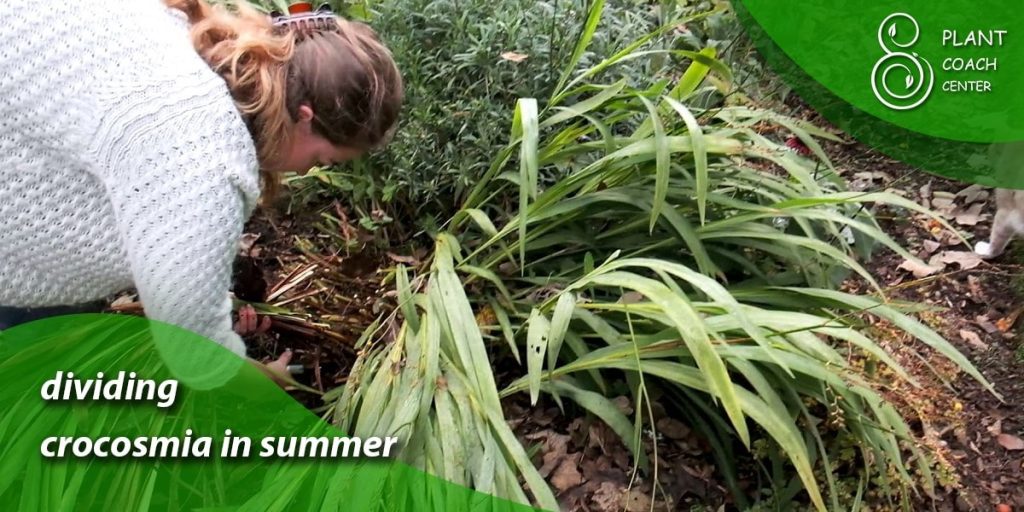
Rescue and Revive: Using Division to Revitalize Neglected Crocosmia
Gardens have an uncanny way of mirroring life’s ebb and flow. Just as we experience moments of neglect and renewal, our plants can fall into periods of neglect that sap their vitality. Crocosmia, with its remarkable beauty, is no exception. However, all hope is not lost when neglect takes its toll—division comes to the rescue as a potent tool for breathing new life into these plants.
Revival Through Rejuvenation
Neglected Crocosmia plants, characterized by dwindling blooms and lackluster foliage, can often be rejuvenated through division. This process reintroduces them to the soil’s nutrients and frees them from the constraints of overcrowding, invigorating their growth and encouraging them to flourish once again.
The Division Transformation
As you divide neglected Crocosmia, carefully separate the congested rhizomes, inspecting them for signs of life and vigor. Trim away any dead or unhealthy portions to focus the plant’s energy on promoting new growth. Giving each division ample space and nourishment allows it to embark on a recovery journey.
Aftercare for Success
Post-division, pay close attention to the revived plants. Adequate water, appropriate sunlight, and a balanced fertilizer regimen will support their comeback. Regularly monitor their progress, celebrating the emergence of fresh shoots and vibrant foliage as a testament to your nurturing efforts.
Patience as a Virtue
Revitalizing neglected Crocosmia through division requires patience. Results may take time, but as the seasons progress, you’ll witness the plants gradually regaining their former splendor. Your commitment to their recovery will be rewarded with stunning displays of color and vigor that remind you of nature’s remarkable ability to rebound.
A Second Chance for Beauty
The process of using division to rescue neglected Crocosmia extends beyond mere horticulture—it’s a profound demonstration of the resilience of both plants and gardeners. As you witness the once-neglected plants thrive anew, you engage in a tangible act of transformation and renewal.
By turning your attention to these plants that may have been overlooked, you’re granting them a second chance to shine and reminding us all that even in gardening, there’s always room for growth, revival, and rekindled beauty.
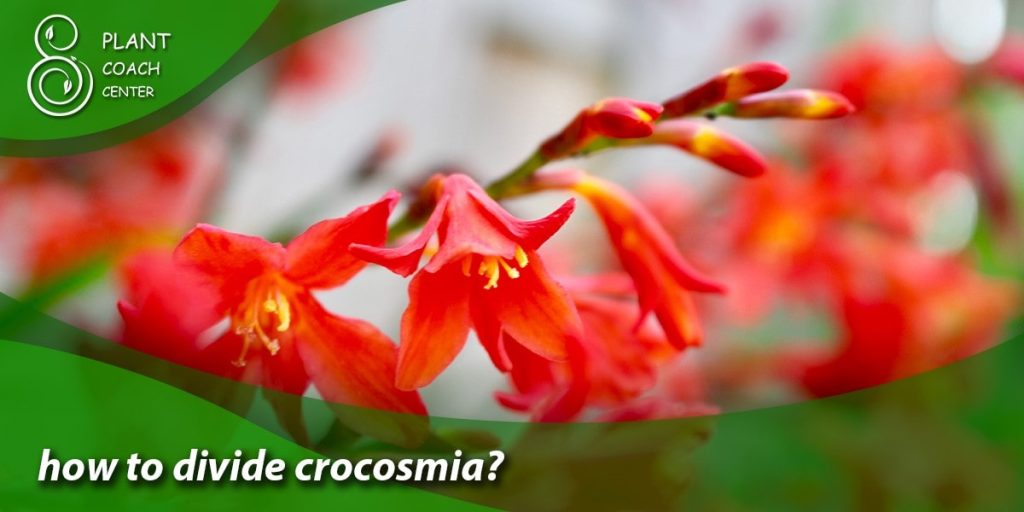
Divide and Conquer: Multiplying Your Crocosmia Collection
The adage “divide and conquer” takes on a new meaning regarding Crocosmia in gardening. With their captivating blooms and striking presence, Crocosmia plants are a treasure that begs to be multiplied. Through division, you can transform a single plant into a bountiful collection that graces your garden with even more splendor.
A Bounty of Blooms:
The act of division is nature’s way of multiplying a plant’s bounty. By separating the crowded rhizomes and replanting them individually, you’re giving each division a fresh start. This revitalizes the parent plant and creates new opportunities for growth, leading to a profusion of blooms that were once hidden within the original clump.
Strategic Placement
Multiplying your Crocosmia collection through division allows you to strategically place the newly divided plants throughout your garden. You can spread their vibrant hues across different beds, borders, or containers, creating visual harmony and balance. The result is an orchestrated symphony of color that transforms your outdoor space into a haven of beauty.
Sharing the Wealth
Division multiplies your collection and opens doors for sharing the beauty with friends and fellow garden enthusiasts. The newly divided sections can be potted and gifted, creating a growth and appreciation chain reaction. Sharing your garden’s bounty fosters community and connection as the plants thrive in new environments.
Long-Term Rewards
Dividing Crocosmia might require effort, but the long-term rewards are undoubtedly worth it. As each division establishes itself and matures, it develops into a self-sustaining plant that contributes to the beauty of your garden for years to come. Your initial investment in the division process will continue to yield dividends through vibrant displays and a flourishing garden.
Harvesting Beauty
As you multiply your Crocosmia collection through division, you participate in a captivating dance of growth and abundance. Each new plant becomes a testament to your nurturing efforts and a living expression of nature’s resilience. The act of dividing and conquering doesn’t just expand your collection—it enhances the overall allure of your garden. It underscores the profound satisfaction of cultivating beauty from the ground up.
Conclusion
In the enchanting realm of gardening, the art of Crocosmia division emerges as a gateway to a world of renewed vitality and boundless beauty. As we’ve explored the nuances of recognizing the signs, mastering the timing, and wielding the essential tools, we’ve uncovered the secrets to unlocking the splendor within these captivating plants. From breathing life into neglected Crocosmia to orchestrating a symphony of colors through multiplication, our journey through this transformative process has showcased the power of our hands in nurturing nature’s wonders.
Whether you’re a seasoned horticulturist or just starting your green journey, the timeless wisdom of the Crocosmia division offers a tangible connection to the rhythms of growth and renewal. So, take your place in the garden as both caretaker and creator, knowing that the guidance in these words is your companion in the remarkable gardening journey.
For more botanical insights and inspiration, visit plantcouchcenter.com and continue your exploration of the plant world’s many wonders.
When should I divide Crocosmia?
Divide in spring or fall, before active growth or after blooming.
How do I know it's ready for division?
Look for overcrowding, reduced blooms, and weaker center growth.
What tools do I need for division?
Garden knife, gloves, spade, watering can, shears, labels, and mulch.


